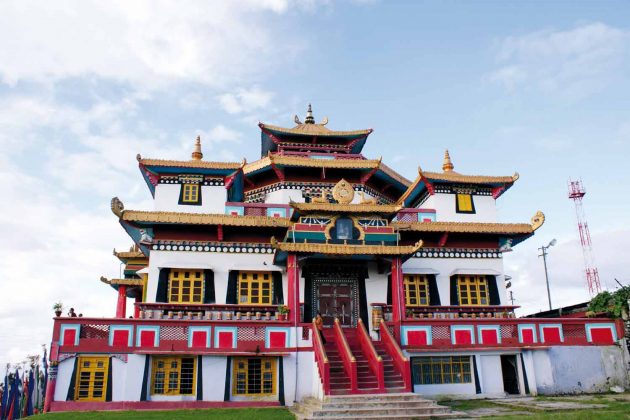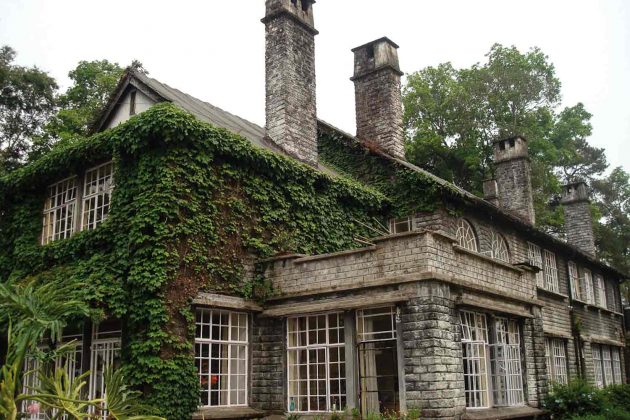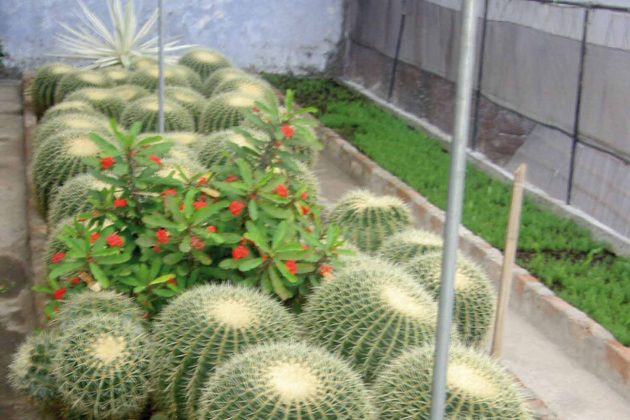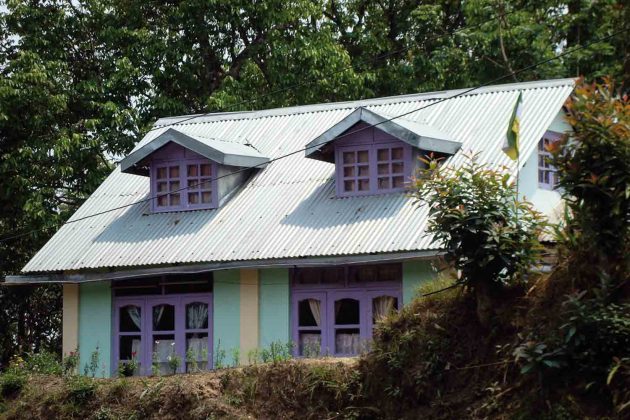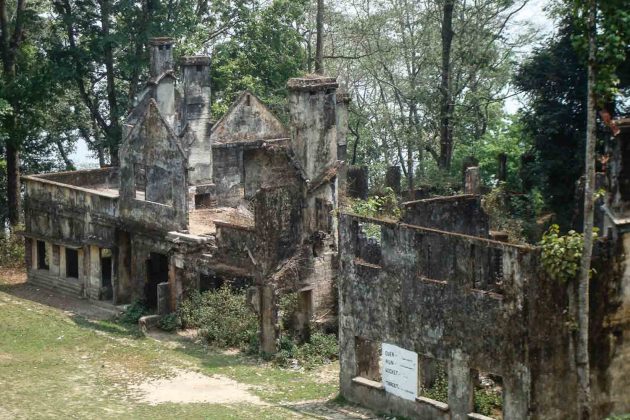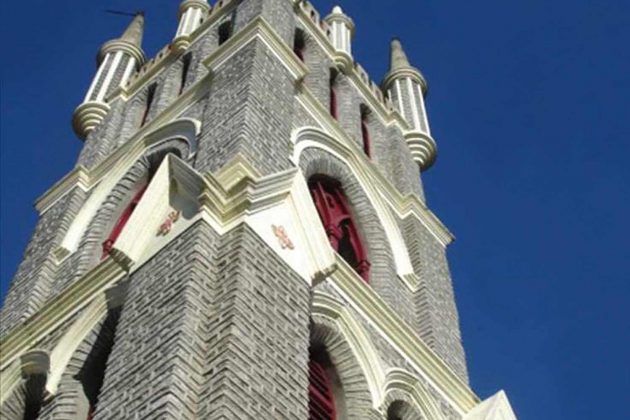There’s something about Kalimpong that sets it apart from other hill-stations. It lacks the typicality that smaller hill towns frequented by weekend tourists acquire; mall roads lined with shops selling hand-knit sweaters, cotton candy or bhutta at every bend and noisy video game parlours tucked between shops promising imported goods. Kalimpong is different. It sits demurely like a Queen on a ridge overlooking the Teesta River in West Bengal.
It was the April of 2010 when a sprightly cabbie drove us into Kalimpong at God’s own speed. My eyes were tightly shut but my ears did not miss noticing how, unlike most taxi drivers, he wasn’t rattling off sites we could see over the next two days of our stay. He kept saying the word “relax” throughout the drive and then “historic!” when he waved us and our two backpacks goodbye outside Morgan House. The import of both words, twined together, came rushing to me when I beheld my lodge, sitting like a grand old man on the outskirts of the town.
It was but evident that Kalimpong was going to make us relax in the lap of History!
The first excursion
Most mountain roads offer two choices—one which makes you ascend and another which makes you descend. After a night spent in a huge room with a fire place and a bathroom overlooking an impeccable golf course, we climbed down a creaking wooden staircase and decided to walk up the road early next morning. High on caffeine and thankful for the pleasant weather, many smiles were exchanged with men in fatigues of the Indian Army’s 27 Mountain Division. Till we came to the end of the road which read Zang Dhok Palri Phodang monastery.
The football match at the monastery
Once upon a time, many Buddhist monks fled Tibet and established monasteries in Kalimpong. Here was the biggest one in front of us, housing rare Buddhist manuscripts, yet seeming as humble and without fanfare as would be expected of a faith purely propagating peace. We walked around its desolate corridors, whispering to each other lest we disturb the syrupy calmness of the place, till we met a friend, the pigeon. There he was, sitting patiently, waiting for the football match to begin as if, while a stone’s throw away, the monks were busy with their early morning sport already!
Ah! Does not Kalimpong translated in Lepcha mean “the ridge where we play”? We must have stood there long enough to become the official spectators of the friendly match which made no sense and yet, in a strange way, spoke volumes about the co-existence of the Nepalis, Lepchas and other ethnic and non-native migrants living in Kalimpong. As if to reinstate the idea of friendship, on our way down from the monastery we bumped into four boys who seemed to have bunked school only to loiter around curvaceous roads, enjoying their companionship and posing happily with it too. A turn away we wondered why they would want to play truant when their school looked just out of a story book. But in a place where even ruins of a past long gone were serving as a cricket scoreboard, it wasn’t hard to guess what exciting alternatives existed to sitting in a classroom!
We got back after the morning sojourn to Morgan House, to a hearty meal justly followed with the flourish of snoozing in our armchairs in the sunny lawns.
Walking through the town
We decided to hit the town the next day, a couple of kilometres of an easy walk in balmy weather, on a narrow road lined with colourful houses on both sides and very clean streets. A lot of these tiny residences had made room for wayward walkers, clearing a settee in a corner of their low-roofed living room and serving instant noodles and hot beverages, all made in their own kitchens. It was a pleasant surprise for us city-dwellers to notice how none of them charged over the marked price, and certainly nothing for the oodles of warm smiles they added to every serving. How many places offer that?
We reached the town-centre in what seemed like a hop-skip-jump. At Thana Dara we stood to catch in a breath, the whole heart of the town. McFarlane Memorial Church waved from another hill-top as we took in the hustle, the bustle and then gradually the unmistakable signs of a different kind of play this time—the play of politics. Hand-written public notices asking for support for the “cause of Gorkhaland” dotted the street corners in all conspicuousness. Some shops included Gorkhaland in their addresses! A movement, which began some decades back, had been revived in the recent past, and through “bandhs” and agitations aimed to write a new chapter in the history books.
As the smell of fresh pastries drew us into the famous 3Cs Bakery on the Main Road, we sat discussing how what seemed so peaceful a day before now showed signs of latent disturbance. The hill-town was in flux, and probably at a point in time which would cleave it along ethnic lines. A Punjab Lodge smiled at us from a distance, as if wondering about its future too, like we were wondering about Kalimpong’s over confectionary and fresh brews. It was over a sumptuous meal at a friend’s place that we learnt more about it all, and how the locals aspired for better infrastructure and development for their dear town, and nothing else.
Cacti galore
Usually, two days of complete relaxation would not involve a steep climb ending in a collection of cacti! But Kalimpong’s Cactus Nursery, with its exhaustive collection of exotic cacti, was worth the time. We thought we had seen enough cacti in our New Delhi terrace gardens but Kalimpong’s array put that notion to shame. What shapes, what sizes; like monsters from another planet which would wrap their prickly arms around our necks, or chase us away down the hill for staring so rudely at them, even if in admiration of their long thorns. It took one panoramic view of Kalimpong from the Pine View Nursery to bring our breaths back, only to be stolen yet again.
Next door to the thorny beauties on Atisha Road was Chitrabhanu, the house where Rabindranath Tagore penned some of his poems. An earthquake had damaged it, and with no repair it reeked of neglect; historic once, forgotten now. Just like the echo of Tagore’s first Live Radio Broadcast from Kalimpong had vanished into the past, never to be heard again. It does good to stand at such doorways, to see in the mind’s eye what transpired behind the wrought-iron gate and in the house which is no longer a part of even memories now.
Time to leave
We were to leave for New Delhi the next day, and the last evening was spent filling up all extra space in our backpacks with Tibetan artifacts and world famous cheeses and lollipops. At the popular Larks on SDBG Road [which was in less agitated times, Rishi Road] we got cheeses and chutneys to make our mundane city lives delicious, creamy and tangy. As if putting all our misgivings about disturbing divisiveness to rest, a “We Love Peaceful Kalimpong” banner confidently hung from near the ceiling. We looked at each other and smiled. It seemed as if the people of Kalimpong were revealing their one and only dream to us before bidding us goodbye. Perhaps ensuring that we would come back to visit their Kalimpong again.
We do plan to go back, but we also wonder if we will see the same Kalimpong or a different one when we go next. Will the old make way for the new, completely? Or will we still see the old and the new co-existing, sometimes on a football field and other times on a chowk lined with summons to revolutions?
Time is playing out its acts on this “ridge where we play”, and people, as usual, are playthings in the hands of those who write history. Watching all this like a queen sits Kalimpong, in rich shades of green, certain of its magnificent Himalayan beauty yet not at all eager to please. Except, that it does, and something tells us it always will!
Photo Credits
- Zang Dhok Palri Phodang monastery: Yeshedorje [rigpawiki.org]
- The Cactus Nursery is a not-to-be missed attraction in Kalimpong: Licensed under [CC BY-SA 2.0] from Eloquence [Wikimedia Commons]
- Rest of the Pictures: Sakshi Nanda


